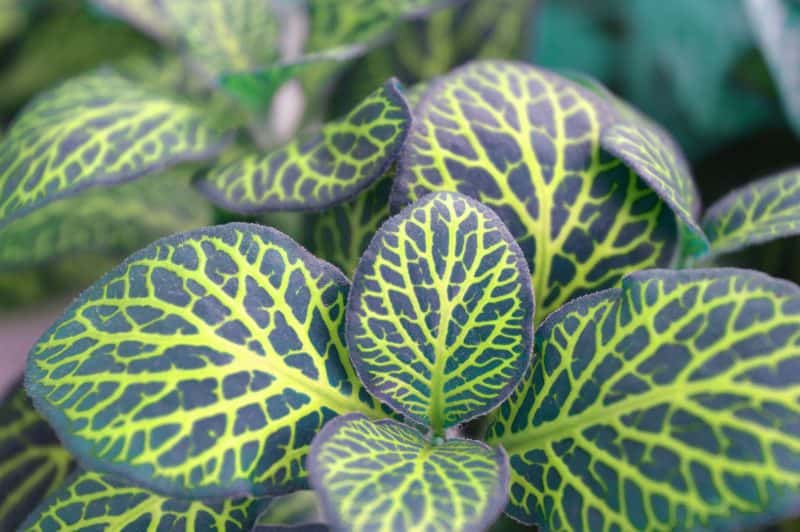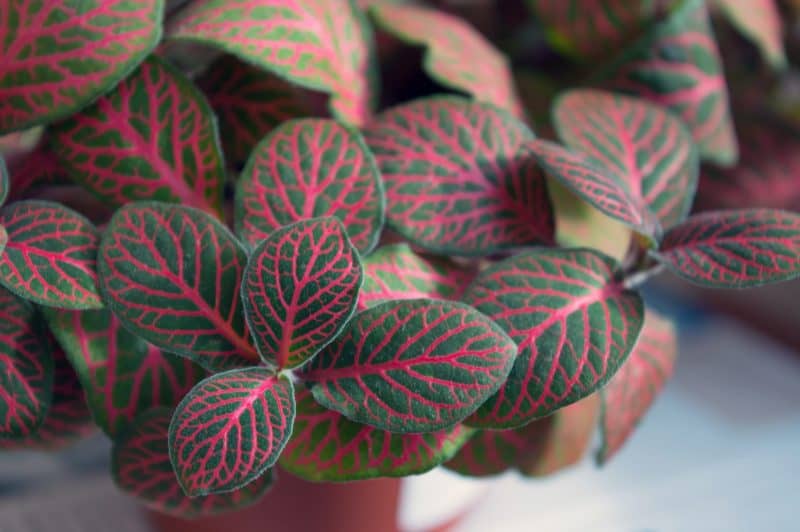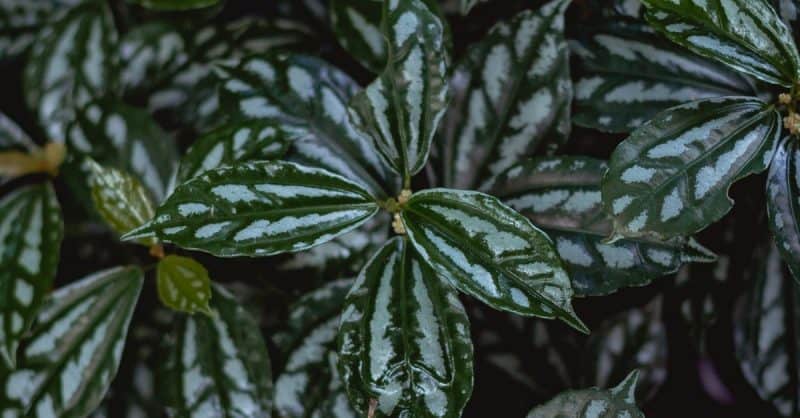This post contains affiliate links. If you buy something from one of our links we may earn a commission. Thanks

Looking for a nerve plant care guide? You’ve come to the right place! In this blog post, we will discuss everything you need to know about growing and maintaining a nerve plant.
This includes tips on watering, fertilizing, and pruning. We’ll also talk about common problems that nerve plants can experience and how to solve them.
So if you’re ready to learn everything there is to know about nerve plants, keep reading!
Fittonia Nerve Plant Care Key Takeaways:
- The Fittonia, or Nerve Plant, flourishes in low to moderate light, avoiding direct sunlight.
- Keep the soil moist, allowing the top inch to dry before re-watering.
- Preferred in humid conditions, a pebble tray or humidifier can maintain humidity.
- During the growing seasons of spring and summer, apply a balanced, half-strength fertilizer once or twice a month, reducing in fall and winter.
What Is A Nerve Plant Anyway?
The nerve plant or Fittonia is a small tropical plant that makes a very attractive houseplant. Here is some background on this plant:
Fittonia (nerve plant) is a genus of flowering plants in the acanthus family Acanthaceae, native to tropical rainforests in South America, mainly Peru.
The most commonly grown are F. albivenis and its cultivars. They are spreading evergreen perennials growing 10–15 cm (4–6 in) tall.
They bear lush green leaves with accented veins of white to deep pink and have a short fuzz covering their stems.
Small buds may appear after a time where the stem splits into leaves. They can also be propagated by allowing the trimmings of the tip to grow roots in about 1-2 weeks.[3]
Flowers are small with a white to off-white color. Plants are best kept in a moist area with mild sunlight and temperatures above 55 °F (13 °C), therefore in temperate areas, they must be grown as houseplants.
Without water for a few days, this plant is known to “faint” but is easily revived with a quick watering. Its spreading habit makes it ideal as a groundcover. Fittonia – Wikipedia
Now that we know what Fittonia is let’s learn how to grow a nerve plant and keep it healthy.
Types of Nerve Plants
Nerve plants are a type of tropical plant that gets its name from its distinctive leaf veins, which resemble nerves.
These eye-catching plants are native to rainforests and make a beautiful addition to any indoor garden.
Nerve plants come in a variety of colors, including green, pink, and purple. They can also be found in both variegated and solid-colored varieties.
In addition to their visually striking leaves, nerve plants are also known for their ability to survive in low-light conditions.
As long as they are getting sufficient moisture, they will thrive in almost any environment.
Whether you are a seasoned gardener or a beginner looking for an easy-care plant, nerve plants are a great option.
With their beautiful foliage and low-maintenance requirements, they are sure to add interest to any indoor space.
Nerve Plant Care Guide In A Nutshell
Nerve plants (Fittonia albivenis) are native to the rainforests of South America, where they grow in shady, moist conditions.
These beautiful plants are known for their vibrant leaves, which are often variegated with shades of green, pink, and white.
Nerve plants make excellent houseplants and can brighten up any indoor space.
However, they can be a bit finicky and require careful care to thrive. Here are some tips for keeping your nerve plant healthy and happy:
• Nerve plants prefer low to moderate light conditions and should not be placed in direct sunlight.
• The soil should be kept moist but not soggy. Allow the top inch of soil to dry out before watering again.
• Nerve plants are sensitive to drafts, so make sure they are not placed near windows or doors.
• Fittonia albivenis will do best in humid conditions. Use a pebble tray or humidifier to maintain the desired level of humidity.
• Regular fertilization is important for nerve plants. Use a balanced fertilizer at half strength once or twice a month during the growing season (spring and summer). Cut back on fertilization in the fall and winter months.
With a little TLC, nerve plants can make beautiful and long-lasting houseplants.
If you’re not sure houseplants are worth the trouble maybe this will change your mind Benefits Of Keeping Indoor Plants For Improved Lifestyle (indoorvegetablegrower.com)
Best Temperature and Humidity For Nerve Plants
Nerve plants are beautiful, low-maintenance houseplants that are loved for their colorful foliage.
These tropical plants are native to Central and South America, and they thrive in warm, humid environments.
If you’re thinking about adding a nerve plant to your home, it’s important to give it the care it needs to thrive.
The ideal temperature range for nerve plants is between 60 and 85 degrees Fahrenheit.
They also prefer high humidity levels, so be sure to mist their leaves regularly or set them on a pebble tray filled with water.

The Right Soil for Nerve Plants
In order to keep your nerve plant healthy and looking its best, it’s important to choose the right type of soil.
Nerve plants prefer soil that is moist but well-drained, so one good choice is a potting mix that contains both peat moss and perlite.
Another good choice is coco coir either with or without perlite.
You want a growing medium that holds water but still allows roots to breathe. Coco coir is superior to peat-based soil mixes in this respect.
In addition, nerve plants do best in an environment with high humidity, so you may want to mist the leaves periodically or set the pot on a tray of pebbles and water.
The Right Light For Fittonia
Fittonia is a beautiful, low-maintenance plant that is perfect for adding a splash of color to any indoor space.
But in order for this plant to thrive, it is important to provide the right type of light.
Fittonia prefers bright, indirect light, such as that found near a window.
The morning sun is OK like from an east window but the afternoon sun can burn the leaves.
If the leaves start to turn yellow or brown, that is a sign that the plant is not getting enough light.
Another way to tell if your Fittonia is getting too much or too little light is to look at the leaves.
If they are getting crispy that means the plant is getting too much light and should be moved to a shadier spot.
If the leaves are pale green or yellow, that means the plant is not getting enough light and needs to be moved to a brighter location.
With the right amount of light, your Fittonia will thrive and add a touch of beauty to your home.
Watering Nerve Plants
When it comes to watering nerve plants, the key is to keep the soil moist without drowning the roots.
These plants are native to humid tropical rainforests, so they’re used to regular watering.
However, too much water can cause the leaves to yellow and drop off.
Signs of overwatering include brown or yellow leaves, wilting, and stunted growth.
One way to water a nerve plant is to use a moisture meter to check the soil before watering.
These meters can be found online or at most garden stores, and they allow you to check the moisture level without having to stick your fingers in the dirt.
If the meter shows that the soil is dry, give the plant a good drink until water starts to drain out of the bottom of the pot.
Then let the soil dry out completely before watering again.
Of course, you can just use your fingers to do this. Personally, I lift the plant to find out if it needs to be watered.
If you do this a few times you will be able to tell if a pot is wet, dry, or in between. Anyone can develop a feel for this over time.
Nerve plants are relatively low-maintenance, but paying attention to their watering needs will help them stay healthy and happy.
Propagating Nerve Plants
Nerve plants are fairly easy to care for and make an excellent addition to any indoor garden. They are also easy to propagate.
For those looking to add more nerve plants to their collection, propagation is a relatively simple process.
New plants can be propagated from stem cuttings taken from an existing plant. Use clean sharp shears and cut the stem at a 45° angle.
You will want a cutting with several nodes and a few leaves. They can be taken any time although some say spring cuttings root faster.
You can dip the end of the cutting in rooting powder to speed up the rooting process but this usually isn’t needed.
The cuttings should be placed in a pot filled with moistened potting mix and placed in a warm, humid location.
After a few weeks, the cuttings will develop roots and can be transplanted into their own pots.
Repotting Nerve Plants
Nerve plants are relatively small, so they can be easily propagated in pots. However, over time, they will eventually outgrow their pots and need to be repotted.
The best time to repot a nerve plant is in the spring before the plant begins to actively grow.
When choosing a new pot, be sure to select one that is only slightly larger than the current pot.
To repot a nerve plant, carefully remove it from its current pot and Shake off any loose soil.
Then, place the plant in the new pot and fill it in with fresh potting mix. Be sure to water thoroughly after repotting.
Because the nerve plant requires regular watering make sure you choose a potting mix that is well-draining.
Peat based soil mixes amended with perlite work well for this and coco coir is also an excellent potting medium.
Are Nerve Plants Poisonous?
According to the ASPCA nerve plants are not poisonous to dogs or cats. I assume they are not toxic for people either.
But it is a houseplant and not a vegetable so don’t try to eat it.
Additional Common Names: Jewel Plant, Silver Nerve, Mosaic Plant, Silver Threads
Scientific Name: Fittonia verschaffeltiiFamily: AcanthaceaeToxicity: Non-Toxic to Dogs, Non-Toxic to Cats, Non-Toxic to Horses
Toxic Principles: Non-toxic Nerve Plant | ASPCA
Nerve Plant FAQs
When diving into the world of Nerve Plants, or Fittonias, a bunch of questions might pop up regarding their care, common issues, and how to ensure they thrive indoors.
In this section, we’ve gathered some frequently asked questions to provide you with a deeper understanding and solutions to common problems you might encounter on your Fittonia journey.
Q. Why are the leaves of my Fittonia turning yellow?
A. Yellowing leaves on a Fittonia often signal over-watering. It’s essential to let the top inch of soil dry before watering again to prevent this issue.
Q. How can I prevent root rot in my Fittonia?
A. Root rot occurs when the soil around the roots becomes waterlogged. Ensure your Fittonia is in well-draining soil and the pot has good drainage to prevent this common problem.
Q. What do dry and wrinkled leaves indicate?
A. Dry and wrinkled leaves often point to inadequate humidity or excessive direct sunlight. Placing your plant in indirect sunlight and maintaining a humid environment can rectify this issue.
Q. My Fittonia wilts when I miss a watering session. Is this normal?
A. Yes, Fittonias can be quite dramatic when a watering session is missed, leading to wilting or fading. However, a good soaking will perk your plant right back up, especially in a terrarium-like environment.
Q. How can I identify and fix common problems with my Fittonia?
A. Keeping an eye on leaf color and ensuring the right balance of water, light, and humidity will help you identify and fix common problems. For instance, yellowing leaves often indicate over-watering or nutrient deficiencies.
Now that you’re equipped with some solutions to common problems, you’re one step closer to mastering the art of Fittonia care. Happy gardening!
Nerve Plant Care Guide Final Thoughts
So, now you know how to grow and care for your Fittonia.
With a little bit of effort, you can have a beautiful, healthy plant that will add a splash of color to any room in your home.
Just remember to water regularly, keep an eye out for pests, and provide plenty of bright indirect light.
With a little bit of care, your Fittonia will thrive for years to come.
Consider trying a closely related houseplant the Purple Waffle Plant.







